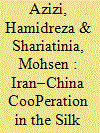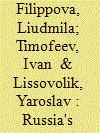| Srl | Item |
| 1 |
ID:
155242


|
|
|
|
|
| Summary/Abstract |
Iran served as a bridge in the ancient Silk Road, connecting the East and the West. It also has great potential to play an important role in the new Silk Road. The present study analyzes the factors affecting Iran–China cooperation in the context of the Belt and Road Initiative at the strategic and operational levels. This article shows that, at the strategic level, Iran defines this project as an opportunity to improve its status in the world economy, expanding its room to manoeuvre in the international arena and developing its ties with China, a rising great power. At the operational level, the opportunities and challenges for Iran–China cooperation could be summarized as pertaining to five realms within the Silk Road Economic Belt Initiative: policy coordination, facilitation of connectivity, unimpeded trade, financial integration and people-to-people bonds. The present study asserts that the main opportunity for cooperation between the two countries lies in facilitating connectivity and that the key challenge is financial integration.
|
|
|
|
|
|
|
|
|
|
|
|
|
|
|
|
| 2 |
ID:
155243


|
|
|
|
|
| Summary/Abstract |
The article aims to highlight Russian approaches to Chinese One Belt-One Road initiative. It examines possible opportunities and challenges for co-development of the Eurasian Economic Union and the Belt project. Both projects and their co-development may reduce the uncertainty in Eurasia, caused by significant structural changes in international relations and the world economy, the emergence of new trade regimes and the erosion of leadership in international affairs. Russian interests in this regard are determined by the need for modernization and long-term development, which could also help to address acute security issues. These particular factors encouraged Russia to come up with an ambitious plan of the Extensive Eurasian Partnership, although the prospects of its implementation currently are uncertain. The present article argues that the success of Russia-China collaboration in Eurasia will depend crucially on the future dynamics of the Eurasian integration, as well as on the agreement to co-develop the Eurasian Economic Union and the Belt Initiative with concrete and mutually beneficial projects.
|
|
|
|
|
|
|
|
|
|
|
|
|
|
|
|